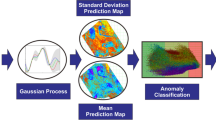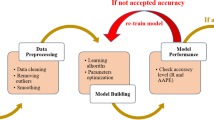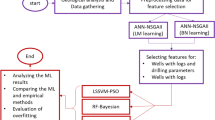Abstract
Porosity is an important petrophysical parameter that determines the amount of fluid, including oil, water, and gas contained within the rock. In petroleum exploration, it plays a crucial role in reservoir characterization, petrophysical studies, and geological analysis. However, in practice, porosity logs do not enumerate in the recorded logs for the entire well, either due to instrumental error or borehole environmental issues. Thus, the prediction of the porosity logs is essential to perform better petrophysical analysis and reservoir characterization. In the present study, we emphasize the implementation of machine learning (ML) approaches in predicting porosity logs at the missing data interval. Here, we predicted the porosity log from the sonic, bulk density, and gamma log. Initially, using the existing data from the well, we prepared the training sample. Further, using the extreme gradient boosting (XGBoost) and random forest (RF) ML approaches, we obtained the mapping function between the input logs (bulk density, gamma, and p-wave velocity logs) and output log (neutron porosity) of the training sample. Subsequently, using the mapping functions of the trained RF and XGBoost models, we obtained the porosity at the test wells at the missing data intervals. The outcome of the present study is satisfactory enough as we have seen the correlation coefficient values of the actual and predicted porosity vary between 0.8 and 0.9. Thus, ensemble machine learning approaches could provide other petrophysical parameters at the missing data interval.











Similar content being viewed by others
References
Adelinet M and Le Ravalec M 2015 Effective medium modeling: How to efficiently infer porosity from seismic data; Interpretation 3(4) SAC1–SAC7.
Allen D M 1974 The relationship between variable selection and data augmentation and a method for prediction; Technometrics 16(1) 125–127.
Aria M, Cuccurullo C and Gnasso A 2021 A comparison among interpretative proposals for random forests; Mach. Learn. Appl. 6 100094.
Bader S, Wu X and Fomel S 2019 Missing log data interpolation and semiautomatic seismic well ties using data matching techniques; Interpretation 7(2) T347–T361.
Berrar D and Dubitzky W 2013 Bootstrapping; In: Encyclopedia of Systems Biology (eds) Dubitzky W, Wolkenhauer O, Cho K H and Yokota H, Springer, New York, NY, https://doi.org/10.1007/978-1-4419-9863-7_644.
Bishop C M 2006 Pattern recognition and machine learning; Springer, New York.
Bosch M 2004 The optimization approach to lithological tomography: Combining seismic data and petrophysics for porosity prediction; Geophysics 69(5) 1272–1282.
Breiman L 1996 Bagging predictors; Mach. Learn. 24(2) 123–140.
Breiman L 2001 Random forests; Mach. Learn. 45(1) 5–32.
Chen Y, Zhao L, Pan J, Li C, Xu M, Li K, Zhang F and Geng J 2021 Deep carbonate reservoir characterisation using multi-seismic attributes via machine learning with physical constraints; J. Geophys. Eng. 18(5) 761–775.
Darling T 2005 Well logging and formation evaluation; Elsevier, Amsterdam, The Netherlands.
Ellis D V and Singer J M 2007 Well logging for Earth Scientists; Springer, Dordrecht.
Feng R, Grana D and Balling N 2021 Imputation of missing well log data by random forest and its uncertainty analysis; Comput. Geosci. 152 104763.
Friedman J H 2001 Greedy function approximation: A gradient boosting machine; Ann Stat. 29(5) 1189–1232.
Gholami A and Ansari H R 2017 Estimation of porosity from seismic attributes using a committee model with bat-inspired optimization algorithm; J. Pet. Sci. Eng. 152 238–249.
Gogoi T and Chatterjee R 2019 Estimation of petrophysical parameters using seismic inversion and neural network modeling in Upper Assam Basin, India; Geosci. Front. 10(3) 1113–1124.
Heidari Z, Torres-Verdin C and Preeg W E 2010 Improved estimation of mineral and fluid volumetric concentrations in thinly-bedded and invaded formations; In: Transactions of the SPWLA 51st annual symposium.
Heller P L, Angevine C L, Winslow N S and Paola C 1988 Two-phase stratigraphic model of foreland-basin sequences; Geology 16(6) 501–504.
Ho T K 1995 Random decision forests; In: Proceedings of the 3rd international conference on document analysis and recognition; IEEE 1 278–282.
Kumar J, Kumar P C and Sain K 2023 Delineation of oil–water contact within Tipam reservoir: A study from Upper Assam Basin, North–East India; Geol. J. 58(11) 4004–4014.
Lane K 2002 What is robust regression and how do you do it?, https://files.eric.ed.gov/fulltext/ED466697.pdf.
Liu X, Ge Q, Chen X, Li J and Chen Y 2021 Extreme learning machine for multivariate reservoir characterization; J. Pet. Sci. Eng. 205 108869.
Mandal K and Dasgupta R 2013 Upper Assam basin and its basinal depositional history; In: SPG 10th Biennial international conference and exposition, Kochi, India.
Mathur N, Raju S V and Kulkarni T G 2001 Improved identification of pay zones through integration of geochemical and log data: A case study from Upper Assam Basin, India; AAPG Bull. 85(2) 309–323.
Matinkia M, Hashami R, Mehrad M, Hajsaeedi M R and Velayati A 2023 Prediction of permeability from well logs using a new hybrid machine learning algorithm; Petroleum 9(1) 108–123.
Mavko G, Mukerji T and Dvorkin J 2009 The Rock Physics Handbook; Cambridge University Press.
Molnar P and Stock J M 2009 Slowing of India’s convergence with Eurasia since 20 Ma and its implications for Tibetan mantle dynamics; Tectonics 28(3) TC3001.
Naidu B D and Panda B K 1997 Regional source rock mapping in upper Assam Shelf; In: Proceedings of the second international petroleum conference and exhibition; Petrole et Tech. 97 350–364.
Nguyen H, Bui X N, Bui H B and Cuong D T 2019 Developing an XGBoost model to predict blast-induced peak particle velocity in an open-pit mine: A case study; Acta Geophys. 67(2) 477–490.
Pahari S, Singh H, Prasad I V S V and Singh R R 2008 Petroleum Systems of Upper Assam Shelf, India; Geohorizons, pp. 14–21.
Pan S, Zheng Z, Guo Z and Luo H 2022 An optimized XGBoost method for predicting reservoir porosity using petrophysical logs; J. Pet. Sci. Eng. 208 109520.
Pang M, Ba J, Carcione J M, Picotti S, Zhou J and Jiang R 2019 Estimation of porosity and fluid saturation in carbonates from rock-physics templates based on seismic QQ; Geophysics 84(6) M25–M36.
Papoulis A and Unnikrishna Pillai S 2002 Probability, random variables and stochastic processes; 4th edn., McGraw Hill, Boston.
Pham N, Wu X and Zabihi Naeini E 2020 Missing well log prediction using convolutional long short-term memory network; Geophysics 85(4) WA159–WA171.
Phillips G R and Eyring E M 1983 Comparison of conventional and robust regression in analysis of chemical data; Anal. Chem. 55(7) 1134–1138.
Raju S V and Mathur N 1995 Petroleum geochemistry of a part of Upper Assam Basin, India: A brief overview; Org. Geochem. 23(1) 55–70.
Saggaf M M and Nebrija E L 2003 Estimation of missing logs by regularized neural networks; AAPG Bull. 87(8) 1377–1389.
Sahoo M and Gogoi K D 2009 Depositional history, processes and mechanism of Early Miocene sediments of Upper Assam Basin; J. Geol. Soc. India 73(4) 575–585.
Saini A 2021 Gradient boosting algorithm: A complete guide for beginners, https://www.analyticsvidhya.com/blog/2021/09/gradient-boosting-algorithm-a-complete-guide-for-beginners/.
Sarker I H 2021 Machine learning: Algorithms, real-world applications and research directions; SN Comput. Sci. 2(3) 160.
Struminskiy K, Klenitskiy A, Reshytko A, Egorov D, Shchepetnov A, Sabirov A, Vetrov D, Semenikhin A, Osmonalieva O and Belozerov B 2019 Well log data standardization imputation and anomaly detection using hidden Markov models; Pet. Geostat. 1 1–5.
Sun J, Niu Z, Innanen K A, Li J and Trad D O 2020 A theory-guided deep-learning formulation and optimization of seismic waveform inversion theory-guided DL and seismic inversion; Geophysics 85(2) R87–R99.
Uddin S, Khan A, Hossain M E and Moni M A 2019 Comparing different supervised machine learning algorithms for disease prediction; BMC Med. Inform. Decis. Mak. 19(1) 281.
Viberti D 2010 A rigorous mathematical approach for petrophysical estimation; Am. J. Appl. Sci. 7(11) 1509–1516.
Wandrey C J 2004 Sylhet-Kopili/Barail-Tipam Composite Total Petroleum System, Assam Geologic Province, India; US Department of the Interior, US Geological Survey.
Wang C, Deng C and Wang S 2020 Imbalance-XGBoost: Leveraging weighted and focal losses for binary label-imbalanced classification with XGBoost; Pattern Recognit. Lett. 136 190–197.
Xu Y, Zhou Y, Sekula P and Ding L 2021 Machine learning in construction: From shallow to deep learning; Dev. Built Environ. 6 100045.
Zheng D, Hou M, Chen A, Zhong H, Qi Z, Ren Q, You J, Wang H and Ma C 2022 Application of machine learning in the identification of fluvial-lacustrine lithofacies from well logs: A case study from Sichuan Basin, China; J. Pet. Sci. Eng. 215 110610.
Acknowledgements
The Director, WIHG, is thanked and acknowledged for permitting us to publish this work. Thanks are due to dGB Earth Science™ for providing academic license of Opendtect™ v6.6.5 software. DGH-NDR, India, is highly acknowledged and thanked for providing good data for pursuing academic research. The authors are thankful to the anonymous reviewers, Prof S Dasgupta, Editor-in-chief and Dr Upasana S Banerji, Guest editor for their comments and valuable suggestions on earlier version of this manuscript. KS acknowledges DST-SERB for according him with JC Bose National fellowship. This is a Wadia contribution No: WIHG/0300.
Author information
Authors and Affiliations
Contributions
JK: Conceptualization, methodology, analysis and interpretation, manuscript, figures, software. BM: Methodology, manuscript review and editing. KS: Team leader, resource, supervision, review, editing and finalizing manuscript.
Corresponding author
Additional information
Communicated by Upasana S Banerji
This article is part of the Topical Collection: AI/ML in Earth System Sciences.
Rights and permissions
Springer Nature or its licensor (e.g. a society or other partner) holds exclusive rights to this article under a publishing agreement with the author(s) or other rightsholder(s); author self-archiving of the accepted manuscript version of this article is solely governed by the terms of such publishing agreement and applicable law.
About this article
Cite this article
Kumar, J., Mukherjee, B. & Sain, K. Porosity prediction using ensemble machine learning approaches: A case study from Upper Assam basin. J Earth Syst Sci 133, 99 (2024). https://doi.org/10.1007/s12040-024-02310-6
Received:
Revised:
Accepted:
Published:
DOI: https://doi.org/10.1007/s12040-024-02310-6




